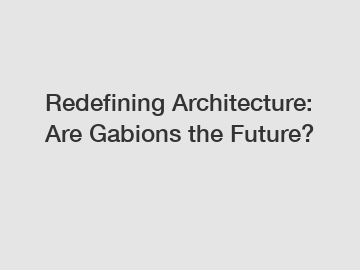Redefining Architecture: Are Gabions the Future?
Apr. 06, 2024
Redefining Architecture: Are Gabions the Future?
Architecture is an ever-evolving field that constantly seeks new materials and techniques to push boundaries and create innovative structures. One material that has been gaining popularity in recent years is gabions. These wire mesh boxes filled with rocks have traditionally been used for retaining walls and erosion control, but architects are now exploring their potential for creating unique and sustainable buildings. Could gabions be the future of architecture?
Benefits of Gabions in Architecture.

Gabions offer numerous benefits that make them an attractive choice for architects looking to redefine traditional building practices. One of the main advantages of gabions is their sustainability. The use of natural stones as fillers and wire mesh made from recycled materials aligns with the growing trend towards eco-friendly construction practices. Gabions also have a low environmental impact as they allow for natural drainage and promote biodiversity by providing habitats for plants and wildlife.
Another key benefit of gabions is their versatility in design. These modular units can be stacked and arranged in various configurations to create walls, facades, partitions, and even entire buildings. The flexibility of gabions allows architects to experiment with different shapes, textures, and patterns, resulting in visually striking and unique structures. Additionally, gabions can be used both indoors and outdoors, making them suitable for a wide range of architectural applications.
Challenges and Considerations.
Despite their many advantages, gabions also present some challenges that architects need to consider. One of the main concerns is maintenance, as the rocks inside the wire mesh boxes may shift over time and require periodic adjustments. Additionally, gabions may not be suitable for all climates or locations, as extreme weather conditions could affect their durability and stability. Architects must carefully assess the site conditions and consult with structural engineers to ensure that gabions are a viable option for their projects.
Furthermore, the aesthetic appeal of gabions may not be to everyone's taste. While some architects appreciate the rugged and industrial look of gabions, others may prefer more traditional building materials. Balancing the visual impact of gabions with the overall design concept of a project can be a creative challenge for architects seeking to integrate this material into their work.
The Future of Gabions in Architecture.
Despite these challenges, gabions have the potential to revolutionize the way architects approach building design. Their sustainable nature, versatility, and aesthetic appeal make them a compelling choice for those looking to push the boundaries of traditional architecture. As more architects experiment with gabions and showcase their innovative projects, we may see a shift towards a new era of construction that prioritizes sustainability and creativity.
In conclusion, gabions offer a promising future for architecture as architects continue to explore their potential and push the boundaries of traditional building practices. The unique combination of sustainability, versatility, and aesthetic appeal makes gabions a material worth considering for innovative and forward-thinking projects. Contact us to learn more about how gabions can redefine architecture and inspire your next design endeavor.
For more euro panel fence exporter, china wooden spool baling wire, custom concertina razor wireinformation, please contact us. We will provide professional answers.
66
0
0


Comments
All Comments (0)